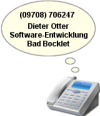Den Pfad einer Anwendung ermitteln - das geht doch einfach wird sich jeder denken. Auch aus einer DLL heraus ist es noch keine Schwierigkeit. Was aber, wenn Sie eine ActiveX-DLL geschrieben haben, und Sie den Pfad der aufrufenden, also instanzierenden Anwendung ermitteln wollen? Da hilft dieser Tipp weiter. Option Explicit ' Benötigte API-Deklarationen Private Declare Function GetFullPathName Lib "kernel32" _ Alias "GetFullPathNameA" ( _ ByVal lpFileName As String, _ ByVal nBufferLength As Long, _ ByVal lpBuffer As String, _ ByVal lpFilePart As String) As Long Private Declare Function CreateToolhelpSnapshot Lib "kernel32" _ Alias "CreateToolhelp32Snapshot" ( _ ByVal lFlgas As Long, _ ByVal lProcessID As Long) As Long Private Declare Function ProcessFirst Lib "kernel32" _ Alias "Process32First" ( _ ByVal hSnapshot As Long, _ uProcess As PROCESSENTRY32) As Long Private Declare Function ProcessNext Lib "kernel32" _ Alias "Process32Next" ( _ ByVal hSnapshot As Long, _ uProcess As PROCESSENTRY32) As Long Private Declare Sub CloseHandle Lib "kernel32" ( _ ByVal hPass As Long) Private Declare Function GetCurrentProcessId Lib "kernel32.dll" () As Long Private Const TH32CS_SNAPPROCESS As Long = 2& Private Const MAX_PATH As Long = 260 Private Type PROCESSENTRY32 dwSize As Long cntUsage As Long th32ProcessID As Long th32DefaultHeapID As Long th32ModuleID As Long cntThreads As Long th32ParentProcessID As Long pcPriClassBase As Long dwflags As Long szexeFile As String * MAX_PATH End Type ' Pfad der aufrufenden Anwendung ermitteln Private Function GetInstancePath() As String Dim lProcessID As Long Dim lSnapshot As Long Dim uProcess As PROCESSENTRY32 Dim lProcessFound As Long Dim i As Integer Dim sEXEName As String ' aktuelle Prozess-ID ermitteln lProcessID = GetCurrentProcessId lSnapshot = CreateToolhelpSnapshot(TH32CS_SNAPPROCESS, 0&) ' Fehler? If lSnapshot = -1 Then Exit Function ' uProcess-Struktur füllen With uProcess .dwSize = Len(uProcess) ' alle aktiven Prozesse durchlaufen lProcessFound = ProcessFirst(lSnapshot, uProcess) Do While lProcessFound If .th32ProcessID = lProcessID Then ' ProzessID gefunden ' jetzt EXE-Name ermitteln If InStr(.szexeFile, Chr$(0)) > 0 Then sEXEName = Left$(.szexeFile, InStr(.szexeFile, Chr$(0)) - 1) End If Exit Do Else ' ...weitersuchen... lProcessFound = ProcessNext(lSnapshot, uProcess) End If Loop End With ' vollständigen Pfad ermitteln Dim nBuffer As String Dim nFilePart As String Dim nLen As Long nBuffer = Space$(255) nLen = GetFullPathName(sEXEName, Len(nBuffer), nBuffer, nFilePart) If nLen Then sEXEName = Left$(nBuffer, nLen) GetInstancePath = sEXEName End Function Dieser Tipp wurde bereits 13.400 mal aufgerufen.
Anzeige
 Diesen und auch alle anderen Tipps & Tricks finden Sie auch auf unserer aktuellen vb@rchiv Diesen und auch alle anderen Tipps & Tricks finden Sie auch auf unserer aktuellen vb@rchiv (einschl. Beispielprojekt!) Ein absolutes Muss - Geballtes Wissen aus mehr als 8 Jahren vb@rchiv! - nahezu alle Tipps & Tricks und Workshops mit Beispielprojekten - Symbol-Galerie mit mehr als 3.200 Icons im modernen Look Weitere Infos - 4 Entwickler-Vollversionen (u.a. sevFTP für .NET), Online-Update-Funktion u.v.m. |
sevISDN 1.0  Überwachung aller eingehender Anrufe! Die DLL erkennt alle über die CAPI-Schnittstelle eingehenden Anrufe und teilt Ihnen sogar mit, aus welchem Ortsbereich der Anruf stammt. Weitere Highlights: Online-Rufident, Erkennung der Anrufbehandlung u.v.m. Tipp des Monats Heinz Prelle Datei-Mehrfachauswahl an eine ListBox übergeben Dieser Tipp zeigt, wie Sie über den Windows-CommonDialog eine Mehrfach-Dateiauswal realisieren... sevOutBar 4.0  Vertikale Menüleisten á la Outlook Erstellen von Outlook ähnlichen Benutzer- interfaces - mit beliebig vielen Gruppen und Symboleinträgen. Moderner OfficeXP-Style mit Farbverläufen, Balloon-Tips, u.v.m. |
||||||||||||||||
|
Microsoft, Windows und Visual Basic sind entweder eingetragene Marken oder Marken der Microsoft Corporation in den USA und/oder anderen Ländern. Weitere auf dieser Homepage aufgeführten Produkt- und Firmennamen können geschützte Marken ihrer jeweiligen Inhaber sein. |
|||||||||||||||||


 Pfad der aufrufenden Anwendung ermitteln (COM-Objekt)
Pfad der aufrufenden Anwendung ermitteln (COM-Objekt)